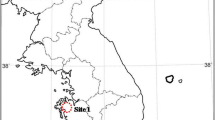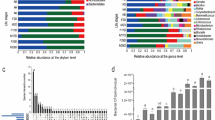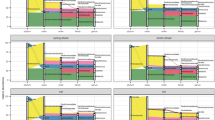Abstract
Busseola fusca (Fuller) (Lepidoptera: Noctuidae) is a stemborer pest that attacks maize (Zea mays) throughout sub-Saharan Africa. Genetically modified maize has been shown to be effective against B. fusca. However, resistance of B. fusca against Bt-maize has developed and spread throughout South Africa. Previous studies suggested that gut microbiota contribute to mortality across a range of Lepidoptera. To fully assess the role of microbiota within the gut, it is essential to understand the microbiota harboured by natural B. fusca populations. This study aimed to identify the gut-associated bacteria by 16S rRNA gene sequencing. A total of 78 bacterial strains were characterised from the midgut of B. fusca larvae that were collected from 30 sites across the maize producing region of South Africa. Molecular phylogenetic analyses revealed bacteria affiliated to Proteobacteria, Actinobacteria, and Firmicutes. Taxonomic distribution placed these isolates into 15 different genera representing 20 species. The majority of bacteria identified belong to the genera Bacillus, Enterococcus, and Klebsiella. The B. fusca gut represents an intriguing and unexplored niche for analysing microbial ecology. The study could provide opportunities for developing new targets for pest management and contribute to understanding the phenomenon of resistance evolution of this species.
Graphical Abstract



Similar content being viewed by others
References
Anand AAP, Vennison SJ, Sankar SG, Prabhu DI, Vasan PT, Raghuraman T, Geoffrey CJ, Vendan SE (2010) Isolation and characterization of bacteria from the gut of Bombyx mori that degrade cellulose, xylan, pectin and starch and their impact on digestion. J Insect Sci 10:107
Ateyyat MA, Shatnawi M, Al-Mazra’awi MS (2010) Isolation and identification of culturable forms of bacteria from the sweet potato whitefly Bemesia tabaci Genn. (Homoptera: Aleyrodidae) in Jordan. Turk J Agric For 34:225–234
Boissière A, Tchioffo MT, Bachar D, Abate L, Marie A, Nsango SE, Shahbazkia HR, Awono-Ambene PH, Levashina EA, Christen R, Morlais I (2012) Midgut microbiota of the malaria mosquito vector Anopheles gambiae and interactions with Plasmodium falciparum infection. PLoS Pathog 8:e1002742
Bravo A, Gill SS, Soberón M (2005) Bacillus thuringiensis mechanisms and use. In: Gilbert LI, Iatrou K, Gill SS (eds) Comprehensive molecular insect science. Elsevier Science, Oxford, pp 175–206
Brink DE (2012) Diversity of gut-microorganisms in Bt-resistant and Btsusceptible larvae of the maize stem borer (Busseola fusca) (Lepidoptera: Noctuidae). M.Sc. Dissertation, North-West University
Brinkmann N, Martens R, Tebbe CC (2008) Origin and diversity of metabolically active gut bacteria from laboratory-bred larvae of Manduca sexta (Sphingidae, Lepidoptera, Insecta). Appl Environ Microbiol 74:7189–7196
Broderick NA, Raffa KF, Goodman RM, Handelsman J (2004) Census of the bacterial community of the gypsy moth larval midgut by using culturing and culture-independent methods. Appl Environ Microbiol 70:293–300
Broderick NA, Raffa KF, Handelsman J (2006) Midgut bacteria required for Bacillus thuringiensis insecticidal activity. Proc Natl Acad Sci USA 103:15196–15199
Broderick NA, Robinson CJ, McMahon MD, Holt J, Handelsman J, Raffa KF (2009) Contributions of gut bacteria to Bacillus thuringiensis-induced mortality vary across a range of lepidoptera. BMC Biol 7:e11
Busse H-J, Wieser M, Buczolits S (2012) Genus III Arthrobacter. The actinobacteria. In: Goodfellow M, Kampfer P, Busse H-J et al (eds) Bergey’s manual of systematic bacteriology, 2nd edn. Springer Verlag, New York, pp 578–624
Çakici FO, Sevim A, Demirbağ Z, Demir İ (2014) Investigating internal bacteria of Spodoptera littoralis (Boisd.) (Lepidoptera: Noctuidae) larvae and some Bacillus strains as biocontrol agents. Turk J Agric For 38:99–110
Calatayud P-A, Le Ru BP, van den Berg J, Schulthess F (2014) Ecology of the African maize stalk borer, Busseola fusca (Lepidoptera: Noctuidae) with special reference to insect-plant interactions. Insects 5:539–563
Chandel K, Mendki MJ, Parikh RY, Kulkarni G, Tikar SN, Sukumaran D, Prakash S, Parashar BD, Shouche YS, Veer V (2013) Midgut microbial community of Culex quinquefasciatus mosquito populations from india. PLoS ONE 8:e80453
Chen S, Yang L, Hu M, Liu J (2011) Biodegradation of fenvalerate and 3-phenoxybenzoic acid by a novel Stenotrophomonas sp. strain ZS-S-01 and its use in bioremediation of contaminated soils. Appl Microbiol Biotechnol 90:755–767
Engel P, Moran NA (2013) The gut microbiota of insects-diversity in structure and function. FEMS Microbiol Rev 37:699–735
Engel P, Martinson VG, Moran NA (2012) Functional diversity within the simple gut microbiota of the honey bee. Proc Natl Acad Sci USA 109:11002–11007
George DM, Rind FC, Bendall MW, Taylor MA, Gatehouse AM (2012) Developmental studies of transgenic maize expressing Cry1Ab on the African stem borer, Busseola fusca; effects on midgut cellular structure. Pest Manag Sci 68:330–339
Gupta AK, Nayduch D, Verma P, Shah B, Ghate HV, Patole MS, Shouche YS (2012) Phylogenetic characterization of bacteria in the gut of house flies (Musca domestica L.). FEMS Microbiol Ecol 79:581–593
Gupta AK, Rastogi G, Nayduch D, Sawant SS, Bhonde RR, Shouche YS (2014) Molecular phylogenetic profiling of gut-associated bacteria in larvae and adults of flesh flies. Med Vet Entomol 28:345–354
He C, Nan X, Zhang Z, Li M (2013) Composition and diversity analysis of the gut bacterial community of the oriental armyworm, Mythimna separata, determined by culture-independent and culture-dependent techniques. J Insect Sci 13:165
Hendriksma HP, Küting M, Härtel S, Näther A, Dohrmann AB, Steffan-Dewenter I, Tebbe CC (2013) Effect of stacked insecticidal cry proteins from maize pollen on Nurse bees (Apis mellifera Carnica) and their gut bacteria. PLoS ONE 8:e59589
Johnston PR, Crickmore N (2009) Gut bacteria not required for Bacillus thuringiensis insecticidal activity towards the tobacco hornworm, Manduca sexta. Appl Environ Microbiol 75:5094–5099
Kallimanis A, Kavakiotis K, Perisynakis A, Spröer C, Pukall R, Drainas C, Koukkou AI (2009) Arthrobacter phenanthrenivorans sp. nov., to accommodate the phenanthrene-degrading bacterium Arthrobacter sp. strain Sphe3. Int J Syst Evol Microbiol 59:275–279
Kfir R, Overholt WA, Khan ZR, Polaszek A (2002) Biology and management of economically important lepidopteran cereal stem borers in Africa. Annu Rev Entomol 47:701–731
Kim OS, Cho YJ, Lee K, Yoon SH, Kim M, Na H, Park SC, Jeon YS, Lee JH, Yi H, Won S, Chun J (2012) Introducing EzTaxon: a prokaryotic 16S rRNA gene sequence database with phylotypes that represent uncultured species. Int J Syst Evol Microbiol 62:716–721
Kruger M, Van Rensburg JBJ, Van den Berg J (2011) Resistance to Bt maize in Busseola fusca (Lepidoptera: Noctuidae) from Vaalharts, South Africa. Environ Entomol 40:477–483
Lin X-L, Pan Q-J, Tian H-G, Douglas AE, Liu T-X (2015) Bacteria abundance and diversity of different life stages of Plutella xylostella (Lepidoptera: Plutellidae), revealed by bacteria culture-dependent and PCR-DGGE methods. Insect Sci 22:375–385
Liu Z, Yang C, Qiao CL (2007) Biodegredation of p-nitrophenol and 4-chlorophenol by Stenotrophomonas sp. FEMS Microbiol Lett 277:150–156
Liu F, Chi Y, Wu S, Jia D, Yao K (2014) Simultaneous degradation of cypermethrin and its metabolite, 3-phenoxybenzoic acid, by the cooperation of Bacillus licheniformis B-1 and Sphingomonas sp. SC-1. J Agric Food Chem 62:8256–8262
Mano H, Morisaki H (2008) Endophytic bacteria in the rice plant. Microb Environ 23:109–117
Minard G, Tran F-H, Dubost A, Tran-Van V, Mavingui P, Moro CV (2014) Pyrosequencing 16S rRNA genes of bacteria associated with wild tiger mosquito Aedes albopictus: a pilot study. Front Cell Infect Microbiol 4:59
Moro CV, Tran F-H, Raharimalala FN, Ravelonandro P, Mavingui P (2013) Diversity of culturable bacteria including Pantoea in wild mosquito Aedes albopictus. BMC Microbiol 13:70
Osei-Poku J, Mbogo CM, Palmer WJ, Jiggins FM (2012) Deep sequencing reveals extensive variation in the gut microbiota of wild mosquitoes from Kenya. Mol Ecol 21:5138–5150
Powell JE, Martinson VG, Urban-Mead K, Moran NA (2014) Routes of acquisition of the gut microbiota of the honey bee Apis mellifera. Appl Environ Microbiol 80:7378–7387
Priya NG, Ojha A, Kajla MK, Raj A, Rajagopal R (2012) Host plant induced variation in gut bacteria of Helicoverpa armigera. PLoS ONE 7:e30768
Raymond B, Johnston PR, Wright DJ, Ellis RJ, Crickmore N, Bonsall MB (2009) A mid-gut microbiota is not required for the pathogenicity of Bacillus thuringiensis to diamondback moth larvae. Environ Microbiol 11:2556–2563
Robinson CJ, Schloss P, Ramos Y, Raffa K, Handelsman J (2010) Robustness of the bacterial community in the cabbage white butterfly larval midgut. Microb Ecol 59:199–211
Sahoo NK, Pakshirajan K, Ghosh PK, Ghosh A (2011) Biodegradation of 4-chlorophenol by Arthrobacter chlorophenolicus A6: effect of culture conditions and degradation kinetics. Biodegradation 22:275–286
Singh BK, Walker A (2006) Microbial degradation of organophosphorus compounds. FEMS Microbiol Rev 30:428–471
Tagliavia M, Messina E, Manachini B, Cappello S, Quatrini P (2014) The gut microbiota of larvae of Rhynchophorus ferrugineus Oliver (Coleoptera: Curculionidae). BMC Microbiol 14:136
Talaei-Hassanloui R, Bakhshaei R, Hosseininaveh V, Khorramnezhad A (2014) Effect of midgut proteolytic activity on susceptibility of lepidopteran larvae to Bacillus thuringiensis subsp. kurstaki. Front Physiol 4:406
Tang X, Freitak D, Vogel H, Ping L, Shao Y, Cordero EA, Andersen G, Westermann M, Heckel DG, Boland W (2012) Complexity and variability of gut commensal microbiota in polyphagous lepidopteran larvae. PLoS ONE 7:e36978
Van den Berg J, Hilbeck A, Bøhn T (2013) Pest resistance to Cry1Ab Bt maize: field resistance, contributing factors and lessons from South Africa. Crop Prot 54:154–160
Van Rensburg JBJ (2007) First report of field resistance by the stem borer, Busseola fusca (Fuller) to Bt-transgenic maize. S Afr J Plant Soil 24:147–151
Xiang H, Wei G-F, Jia S, Huang J, Miao XX, Zhou Z, Zhao LP, Huang YP (2006) Microbial communities in the larval midgut of laboratory and field populations of cotton bollworm (Helicoverpa armigera). Can J Microbiol 52:1085–1092
Yadav KK, Shariq M, Maurya KS, Alam MN, Ahmad K (2012) Molecular characterization of cellulose degrading bacteria on the basis of 16S rRNA. J Recent Adv Appl Sci 27:80–92
Acknowledgments
This study was partly funded through a collaborative project between NWU and the Centre for Gene Ecology (GenØk), Norway. Post-Doctoral research fellowship awarded by North-West University (NWU), Potchefstroom, South Africa to A.K. Gupta, is gratefully acknowledged. We are grateful to Mr. Abram Mahlatsi for providing valuable ideas and helpful comments in the initial stages of the study and in preparing the manuscript. Dr C. P. Antony, Max Planck Institute for Marine Microbiology, Bremen, Germany, is acknowledged for providing constructive ideas and critically reviewing the final manuscript.
Author information
Authors and Affiliations
Corresponding author
Additional information
Maxi Snyman and Arvind Kumar Gupta have contributed equally.
Rights and permissions
About this article
Cite this article
Snyman, M., Gupta, A.K., Bezuidenhout, C.C. et al. Gut microbiota of Busseola fusca (Lepidoptera: Noctuidae). World J Microbiol Biotechnol 32, 115 (2016). https://doi.org/10.1007/s11274-016-2066-8
Received:
Accepted:
Published:
DOI: https://doi.org/10.1007/s11274-016-2066-8




